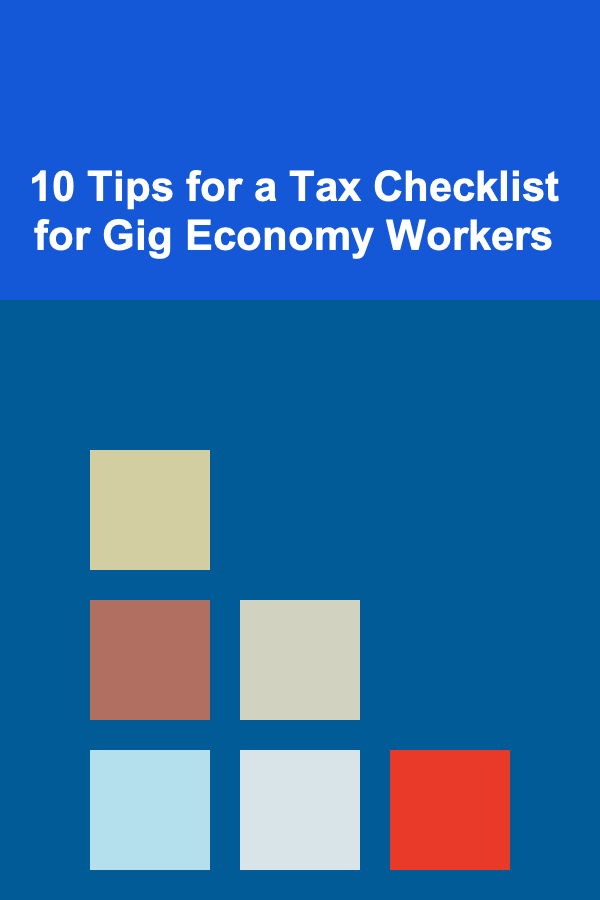
10 Tips for a Tax Checklist for Gig Economy Workers
ebook include PDF & Audio bundle (Micro Guide)
$12.99$11.99
Limited Time Offer! Order within the next:

The gig economy has revolutionized the way people work, offering flexibility, independence, and the opportunity to earn an income on their terms. However, it also presents unique challenges, particularly when it comes to managing taxes. Unlike traditional employees, gig economy workers are typically considered self-employed, which means they bear the responsibility of filing and paying taxes on their own.
As a gig economy worker, it's essential to stay on top of your tax responsibilities to avoid unexpected tax bills or penalties. With the proper preparation, understanding, and organization, you can manage your taxes effectively and ensure compliance with tax laws.
In this article, we'll explore 10 important tips to help gig economy workers create a comprehensive tax checklist that will make filing taxes easier and more efficient.
Understand Your Tax Status as a Gig Economy Worker
The first step to handling taxes as a gig worker is to understand your tax status. Unlike traditional employees, gig workers are generally classified as independent contractors or self-employed. This distinction is crucial because it affects how you file your taxes, the forms you use, and the deductions you can claim.
Independent Contractor vs. Employee
An independent contractor is someone who offers services to clients without being an employee. Gig economy platforms such as Uber, Lyft, and TaskRabbit typically categorize workers as independent contractors. This means that you're responsible for paying both income taxes and self-employment taxes (Social Security and Medicare), which would normally be withheld by an employer in a traditional job.
As an employee, your employer handles payroll taxes and withholds them from your paycheck. As an independent contractor, you're responsible for paying your own taxes, which includes both your income tax and the self-employment tax.
Types of Work in the Gig Economy
The gig economy encompasses a variety of roles, including freelance writing, ride-sharing, food delivery, and many others. Regardless of your specific gig, if you're receiving income for services rendered and not as an employee of a company, you'll likely be considered self-employed for tax purposes.
Keep Track of All Your Income
One of the most important aspects of managing taxes as a gig worker is keeping accurate records of all your income. Whether you're earning money through freelance writing, graphic design, or driving for a ride-sharing service, it's essential to document every dollar you earn.
Organize Income from Multiple Sources
Many gig economy workers earn income from several different sources, such as multiple platforms or clients. Keeping track of these different income streams can be challenging, but it's crucial for accurately reporting your earnings on your tax return.
Consider using accounting software or apps specifically designed for gig workers. These tools can help you track income from different sources, organize receipts, and generate reports for tax filing. Some popular options include QuickBooks, FreshBooks, and Wave.
Review 1099 Forms
As a gig worker, you may receive a 1099 form from clients or companies you work for. This form reports the total income you received during the year from a specific payer. If you earn $600 or more from a particular company or client, they are required to send you a 1099 form. Make sure to review each 1099 you receive for accuracy and keep them in your records for tax filing.
Don't Forget Non-1099 Income
Keep in mind that not all income will come with a 1099 form. If you earn less than $600 from a particular client or service, they are not required to send you a 1099. However, you are still required to report all your income, regardless of whether you receive a 1099 form.
Set Aside Money for Taxes
Since gig workers don't have taxes withheld from their income automatically, it's important to set aside money throughout the year to cover your tax liabilities. Failing to do so can lead to a large tax bill at the end of the year, along with penalties and interest.
Estimate Your Tax Liability
To estimate how much money to set aside, you need to calculate your expected tax liability. This includes both your income tax and self-employment tax (15.3%, which covers Social Security and Medicare). You can use online calculators or consult with a tax professional to get an estimate of your tax obligations.
For example, if you expect to earn $50,000 in net income for the year, you can estimate that you will owe approximately $7,650 in self-employment tax (15.3% of $50,000) plus any income tax.
Set Aside a Percentage of Each Payment
A good rule of thumb is to set aside about 25% to 30% of each payment you receive for taxes. This percentage can vary depending on your tax bracket and location, but it provides a solid starting point. You can adjust this percentage as needed throughout the year based on your earnings.
Use a Separate Bank Account
To make it easier to set aside money for taxes, consider opening a separate savings account specifically for this purpose. Every time you receive payment for your gig work, transfer a percentage of that income into your tax savings account. This ensures that you have the money available when it's time to pay your taxes.
Keep Detailed Records of Your Expenses
One of the advantages of being self-employed is the ability to deduct certain business expenses from your taxable income. However, in order to claim these deductions, you must keep detailed records of your expenses.
Identify Deductible Business Expenses
As a gig economy worker, you can deduct a wide range of business expenses. These may include:
- Supplies and equipment: If you purchase supplies, tools, or equipment that are necessary for your work, you can deduct the cost.
- Home office: If you work from home, you may be able to deduct a portion of your home expenses, such as rent, utilities, and internet bills, as part of the home office deduction.
- Vehicle expenses: If you use your vehicle for gig work (such as driving for Uber or delivering food), you can deduct the costs associated with maintaining and operating your vehicle. You can either deduct actual expenses (gas, maintenance, insurance) or use the standard mileage rate provided by the IRS.
- Software and subscriptions: If you pay for any software, apps, or subscriptions related to your gig work (such as accounting tools or design software), these can be deducted.
- Marketing and advertising: Any money spent on advertising, such as online ads or business cards, can also be deducted.
Keep Receipts and Invoices
To ensure that your deductions are valid, it's essential to keep receipts and invoices for all your business-related purchases. You should also track any recurring expenses, such as subscription services or memberships, to ensure they're accounted for correctly.
Use Accounting Software to Track Expenses
Consider using accounting software that allows you to categorize and track your expenses in real-time. Many programs allow you to link your bank accounts and credit cards, automatically categorizing expenses for you. This can make it easier to track your deductions and prepare for tax season.
Pay Estimated Taxes Quarterly
As a gig worker, you may need to make quarterly estimated tax payments to avoid penalties. These payments cover both your income tax and self-employment tax obligations. The IRS requires self-employed individuals to pay estimated taxes on a quarterly basis if they expect to owe more than $1,000 in taxes for the year.
Determine Your Quarterly Payment Amount
To determine how much you need to pay in estimated taxes, divide your expected tax liability by four. If you expect to owe $10,000 in taxes for the year, you should make four quarterly payments of $2,500 each.
Make Payments Online
The IRS offers several ways to make estimated tax payments, including paying online through the IRS Direct Pay system, using the Electronic Federal Tax Payment System (EFTPS), or mailing a check with Form 1040-ES. Make sure to pay on time to avoid penalties.
Adjust Payments as Needed
If your income fluctuates during the year, be sure to adjust your estimated tax payments accordingly. If you're earning more than expected, increase your payments to avoid a tax bill at the end of the year. Conversely, if you're earning less, you can decrease your payments to reflect your lower tax liability.
Understand Tax Deductions and Credits Available to You
Gig workers have access to a variety of tax deductions and credits that can help reduce their overall tax burden. Understanding these opportunities can make a significant difference in how much you owe at tax time.
Common Tax Deductions for Gig Workers
- Self-Employed Health Insurance: If you pay for your own health insurance, you may be able to deduct the cost of premiums.
- Retirement Contributions: Contributions to a self-employed retirement plan, such as a SEP IRA or Solo 401(k), may be deductible.
- Education and Training: If you take courses or attend training related to your gig work, these expenses may be deductible.
- Business Insurance: If you purchase business insurance (such as liability insurance for a freelance business), you can deduct the premiums.
Tax Credits for Gig Workers
In addition to deductions, gig workers may also be eligible for tax credits. Some common credits include:
- Earned Income Tax Credit (EITC): If you have a low to moderate income, you may qualify for the EITC, which can reduce your tax liability.
- Child Tax Credit: If you have dependents, you may be eligible for the Child Tax Credit, which can provide additional savings.
Be Aware of State and Local Tax Obligations
In addition to federal taxes, gig workers may be subject to state and local taxes. These taxes can vary widely depending on where you live and work. Some states have no income tax, while others have high tax rates.
Research State Tax Requirements
Each state has its own rules and regulations regarding self-employment taxes. Make sure to research the tax requirements in your state and local area to ensure you're in compliance. Some states may require quarterly tax payments, while others may require you to file an annual return.
Sales Tax Considerations
Depending on the nature of your gig work, you may also be required to collect sales tax on goods or services you sell. For example, if you're selling products or offering taxable services, you may need to register for a sales tax permit and collect tax from customers.
File Your Taxes on Time
Filing your taxes on time is crucial to avoid penalties and interest. The IRS typically requires that you file your tax return by April 15th of each year, though the deadline can be extended in certain situations.
File Online or Hire a Tax Professional
You can file your taxes online using IRS Free File or paid tax preparation software. If your tax situation is complex, you may want to consider hiring a tax professional to help you navigate deductions, credits, and filing requirements.
Keep Track of Deadlines
In addition to filing your annual tax return, keep track of quarterly estimated tax payment deadlines. Missing these deadlines can result in penalties and interest, so make sure to mark them on your calendar.
Plan for Retirement
As a gig worker, you are responsible for saving for your own retirement. Unlike traditional employees who may have access to employer-sponsored retirement plans, gig workers must find alternative ways to save for the future.
Contribute to a Retirement Plan
Consider opening a retirement account, such as a SEP IRA or Solo 401(k), to save for retirement while also benefiting from tax deductions. Contributions to these accounts can reduce your taxable income, while the funds grow tax-deferred until retirement.
Set Aside Money Regularly
Just as you set aside money for taxes, it's important to regularly save for retirement. Try to contribute a percentage of your income each month to ensure you are consistently building your retirement savings.
Seek Professional Help When Needed
Navigating taxes as a gig worker can be complex, especially if you're new to self-employment. If you're unsure about any aspect of your tax situation, it's wise to seek professional help.
Hire a Tax Professional
A certified tax professional or accountant can help you understand your tax obligations, identify deductions you may have missed, and ensure your tax return is filed correctly. While there is a cost associated with hiring a professional, it can save you money in the long run by minimizing errors and maximizing deductions.
Consult a Financial Planner
In addition to tax professionals, consider consulting a financial planner who specializes in self-employment. A financial planner can help you manage your income, save for retirement, and create a comprehensive financial plan to ensure long-term financial success.
Conclusion
Managing taxes as a gig economy worker may seem daunting, but with the right preparation, organization, and understanding, you can navigate the process effectively. By following the tips outlined in this article, you can ensure that you're meeting your tax obligations, maximizing your deductions, and setting yourself up for long-term financial success. Keep accurate records, set aside money for taxes, and seek professional help when needed to stay on top of your tax responsibilities in the gig economy.
Reading More From Our Other Websites
- [Personal Investment 101] How to Start Investing with Little Money and Grow Your Wealth
- [Survival Kit 101] How to Curate a Survival Kit for Seniors with Mobility Challenges
- [Home Security 101] How to Implement Home Security Tips and Tricks for a Safer Living Space
- [Home Space Saving 101] How to Utilize Vertical Storage Solutions
- [Reading Habit Tip 101] Turning the Page: How to Build a Sustainable Reading Routine in 30 Days
- [Personal Care Tips 101] How to Create a Low-FODMAP Meal Plan for IBS Relief
- [Weaving Tip 101] Beyond the Fabric: Integrating Design Theory in Modern Weaving Classes
- [Organization Tip 101] How to Use Hooks and Pegboards for Organized Entryways
- [Home Budget 101] How to Save for a Down Payment: A Step-by-Step Guide
- [Home Pet Care 101] How to Safely Travel with Your Pet in Your Car

How to Budget for Seasonal Expenses and Holidays
Read More
How to Clean Your Home While Dealing with a Busy Schedule
Read More
How To Master Time Management for Project Managers
Read More
How to Use Wall Hangings for Added Sound Absorption
Read More
Social Movements: Understanding Collective Action and Social Change
Read More
How to Identify Birds by Their Beaks and Feet
Read MoreOther Products

How to Budget for Seasonal Expenses and Holidays
Read More
How to Clean Your Home While Dealing with a Busy Schedule
Read More
How To Master Time Management for Project Managers
Read More
How to Use Wall Hangings for Added Sound Absorption
Read More
Social Movements: Understanding Collective Action and Social Change
Read More